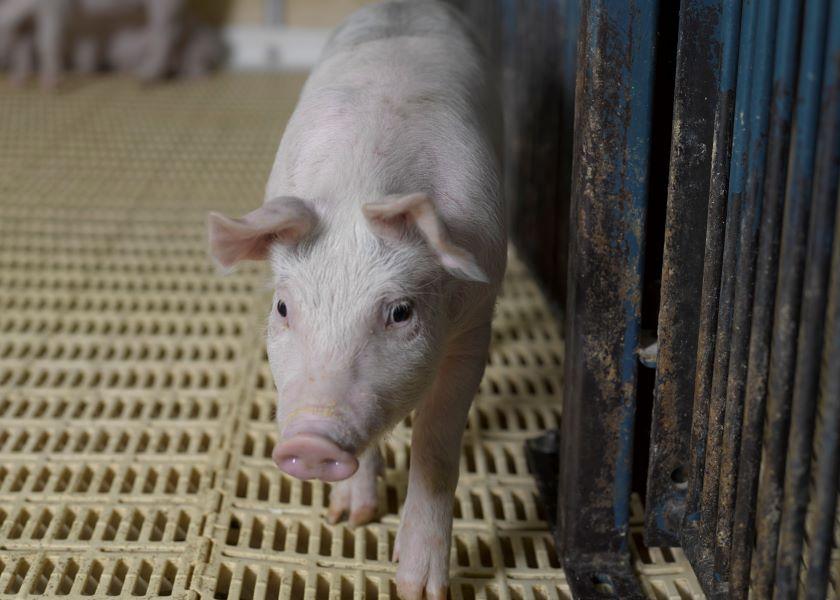Here’s How to Develop Gilts for a Lifetime of Productivity

By Joel DeRouchey, Mike Tokach, Jason Woodworth, Bob Goodband and Jordan Gebhardt of Kansas State University
A successful gilt development program is vital to a production system because it has a direct effect on reproductive performance and sow lifetime productivity. While many management practices such as boar exposure and estrus detection affect reproductive performance, a solid nutrition program is also required.
Why is Nutrition So Important?
A gilt nutritional program should be designed to meet the nutrient demands for adequate protein growth and bone and reproductive tract development. The gilt nutritional program begins at weaning and continues until the end of the first lactation. A well-designed nutritional program should focus on avoiding nutrient deficiencies and preventing over-conditioning upon entry into the sow herd.
Optimizing growth rate early in the gilt’s life has been shown to be beneficial for lifetime productivity. During the preweaned stage, inadequate colostrum consumption after birth can lead to reduced growth rate. A reduction in growth rate during the preweaning stage could lead to delays in puberty attainment and negatively affect reproductive tract development.
Research has shown that creating smaller litters for gilts destined for the sow population post-farrowing to reduce suckling pressure is beneficial for preweaning growth rate, reproductive performance and lifetime productivity. Because of this, it is recommended to create smaller litters for gilts destined for the sow population to potentially benefit colostrum intake and lifetime productivity.
Nutrient Recommendations
During the nursery stage, dietary nutrient recommendations should be similar to commercial pig requirements. This is because a reduction in postweaning gain can lead to decreases in successful mating and reproductive performance. During the grow-finish period, ad libitum feeding of a grow-finish diet with moderate levels of energy and amino acids is recommended. This is because increasing the lysine:calorie ratio above normal grow-finish levels shows no evidence for effects on puberty onset or ovulation rate, while severe restriction can lead to delayed puberty. Severely restricting energy below growth and maintenance requirements in an effort to slow growth rate during rearing can lead to delays in the expression of estrus.
Dietary calcium and phosphorous concentrations fed from 50 to 300 pounds should be increased compared to diets fed to commercial finishing pigs to maximize bone mineral content, according to the National Research Council’s 2012 Nutrient Requirements of Swine. Although this does not necessarily alter growth performance or affect structural soundness, it provides improved bone strength characteristics.
Take Age and Weight into Consideration
The age and body weight of gilts moved to the breeding herd from the gilt developer facility may affect how diets are formulated. If the replacement gilts are moved to the breeding herd well in advance of typical market weight, then development diets should be fed to match the needs of the growing gilt.
If replacement gilts are moved to gestation at regular market weight prior to first breeding, they are often switched to gestation diet. This is done to increase key vitamins such as choline, biotin, pyridoxine and folic acid that are necessary for embryo development.
When gilts are moved to gestation before breeding, they are generally limit fed. In this case, approximately two weeks prior to breeding, feed intake should be increased by approximately 2 lb. per gilt per day to increase energy intake. The increased energy intake can increase the number of eggs ovulated prior to breeding. This practice is commonly referred to as “flushing.”
After breeding, adjust feed intake to regular gestation levels to match her body condition. This helps avoid rapid weight gain during gestation and prevents over-conditioned gilts entering their first lactation. Over-conditioned gilts will have decreased lactation feed intake and negative subsequent reproductive performance.
Body Criteria Targets Before First Breeding
Target body weight for gilts at breeding should be between 300 to 340 lb. to optimize reproductive performance and longevity in the sow herd. This weight threshold is needed at breeding to ensure gilts will not lose excessive protein reserves during their first lactation.
Gilts generally have lower lactation feed intake which results in increased mobilization of protein stores for milk production and can lead to decreased reproductive performance. In addition, breeding gilts at lighter or heavier weights can decrease total born over their entire lifetime or potentially result in increased stillborn pigs and lameness issues, respectively. Therefore, bodyweight should be used as the target criteria before first breeding to optimize reproductive performance.
More from Farm Journal's PORK:
Consider Heat Increment of Digestion When Formulating Sow Diets
Deciphering the Gray Areas of Proposition 12
Precision Feeding: What’s Best for the Sow?
High-Oil Corn Packs Punch for Pigs







